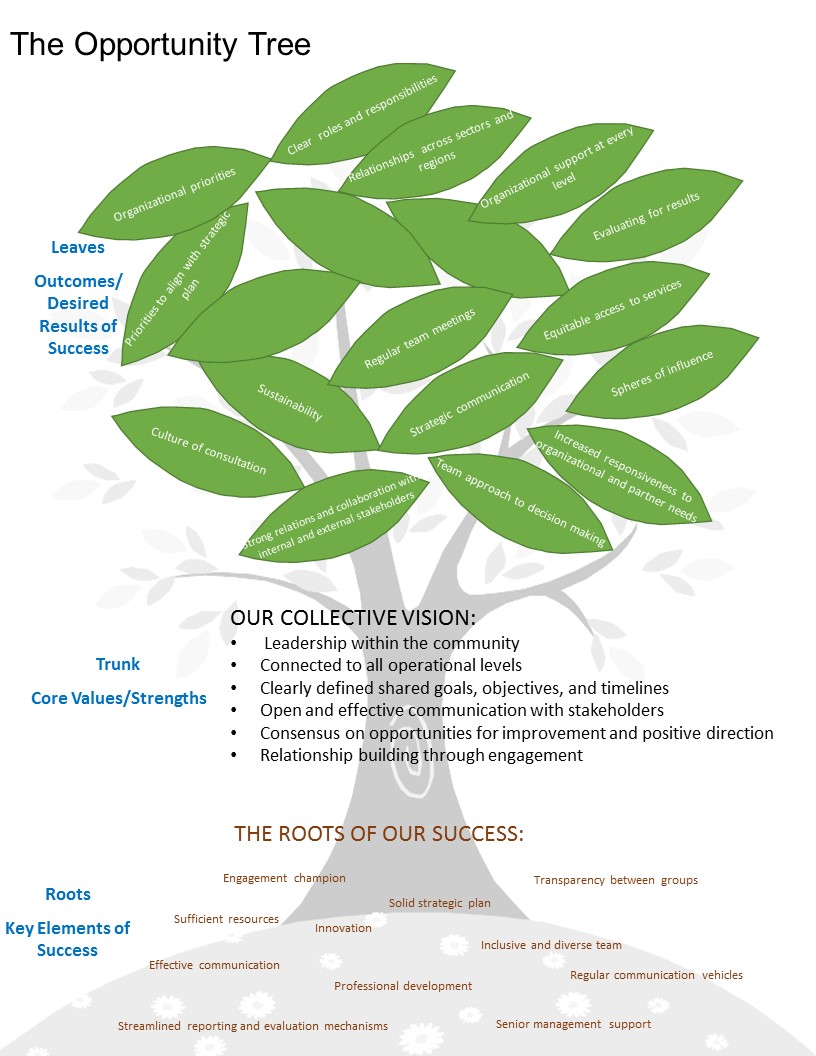Featured Technique: The Opportunity Tree

“A vivid imagination compels the whole body to obey it.” –Aristotle
The context:
The Opportunity Tree is a thinking framework that helps people visualize and frame the collective impact they want to make.
In the last two years, Engage Delaney has supported several strategic planning initiatives with hospitals in Ontario. We’ve observed a move away from top-down strategic planning initiatives toward inclusive, aspirational engagement in which partners and the community are invited into the planning process.
These hospitals have found that the Opportunity Tree concept is useful for engaging their communities and partners. Rather than falling into the trap of a focusing on the ‘problems’ of the organization, their stakeholders and partners can be asked to participate in the exploration of the ‘opportunity’ that exists for the hospital.
Groups need to see their collective imagination reflected, and an Opportunity Tree displayed on the wall reflects just that.
Why use this technique?
The Opportunity Tree is a concept credited to Malcolm Odell, who is a long-time practitioner in Appreciative Inquiry[1]. Malcolm originally designed the method as a reframing process, to help people to move from ‘problem’ to ‘opportunity’. In the way D+A has interpreted the technique, it can be used to generate a sense of alignment between an organization – such as a hospital –and its community and partners.
How does this technique work?
We use the metaphor of a tree to guide a dialogue process. The tree metaphor is highly versatile and creates a structured thinking framework that can be visually displayed – literally on the wall. It is both a discussion framework and a recording template. We design questions relating to the parts of the tree, and have people report back using the tree as a visual tool to capture group knowledge.
An Opportunity Tree has three basic parts: the trunk, the branches and the roots.
In brief:
- The trunk = core operating values and core strengths
- The branches and leaves = the desired results
- The roots = the opportunities that, if grasped, will nourish the results
While there is no prescribed order of discussion, by first discussing the core operating values and strengths in the trunk, then defining desired results in the branches, our team has found that the opportunities in the roots start to emerge organically.
The Trunk
A tree trunk supports the branches, and is the conduit for nutrients in the ground toward the development of the leaves. For the organization to achieve the results it desires, it first needs to understand the core values by which it will operate, and the core strengths that it possesses. The trunk also represents the central image of the ideal future. In a hospital setting, this might be something as simple as a provocative, future-oriented statement that is co-developed by a group of people, or a list of principles / core operating values or core strengths.
An example of a statement in the trunk might be:
“Our hospital is a dynamic, collaborative team creating a vibrant community health hub, providing compassionate urgent care in times of need, and continual preventative care in times of normalcy.”
In this example, dynamism, collaboration, prevention and compassionate care are all elements of how this hospital sees itself at the core.
The Branches
The branches and leaves represent the desired results that the group wishes to see. The results are a rich playground of aspirations, hopes and wishes. By articulating results, people are able to tangibly express what matters to the community that is vested in the organization.
To make them more compelling, statements in the branches are best expressed in present tense, as if the results already exist. Here is an example:
“Every patient feels cared for by every staff member they encounter from the moment they set foot in the door.”
As people clearly identify the actual results they wish to see, it opens up space for the discussion of new and possibly disruptive ‘opportunities’ that might not have been considered before.
The Roots
Roots are buried deeply in the ground, and take the nutrients from the soil in order to feed the development of the branches (results).
Think of opportunities as the ‘key ingredients’ to creating the results. In this sense, they reflect specific opportunities. An opportunity can be expressed as a problem, but it is far more effective to express it and reframe it as a vital solution. For example: A problem like ‘ineffective management of human resources’ can be reframed as an opportunity to ‘create excellent, optimized use of human capital’.
Opportunities aren’t just things that are new. They can be continuation of things that are working well already. The key lies in how the question is asked, and in helping participants reframe their fears and problems into concise opportunity statements that drive the results they want to see.
What is required to pull this off?
- Thoughtfully and carefully design your questions, as well as the process for asking them. We typically use some combination of paired interviews using pre-developed questions, small-group process, and whole-group discussion that utilizes the Opportunity Tree as a guide. This process is not left to chance.
- A large tree picture, large post-it notes, tape and markers are the supplies. (In the past, we’ve printed a tree in advance, but also drawn them on flipcharts in marker).
- A large wall for posting the tree for the whole group to see.
Please call us to learn more about how you might apply the Opportunity Tree to your group challenge, or for advice on how to leverage this powerful process!
[1] The Opportunity Tree technique Engage Delaney uses is adapted from the work of Malcolm Odell (2002). Click here for further information.



